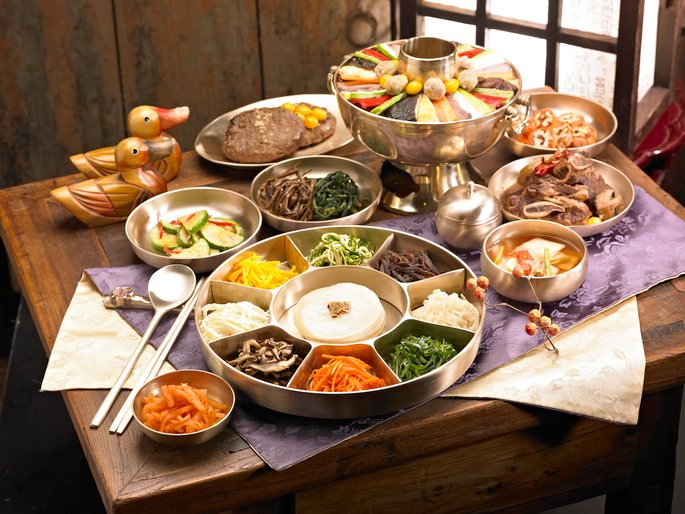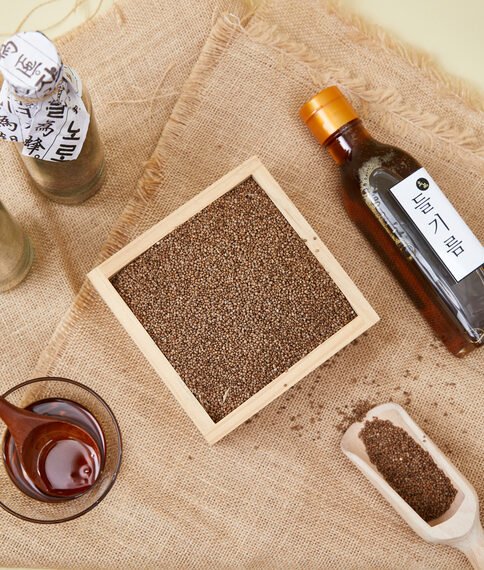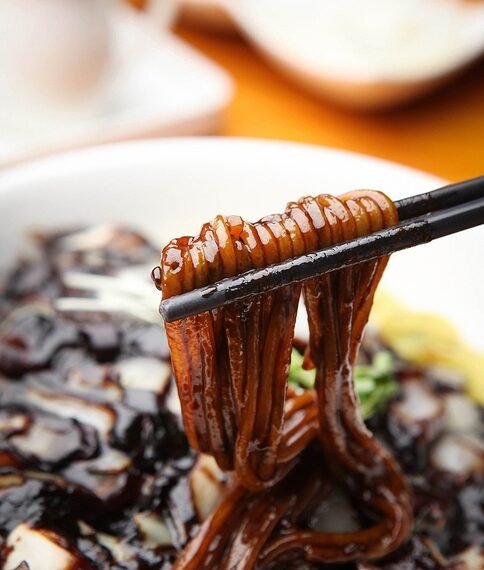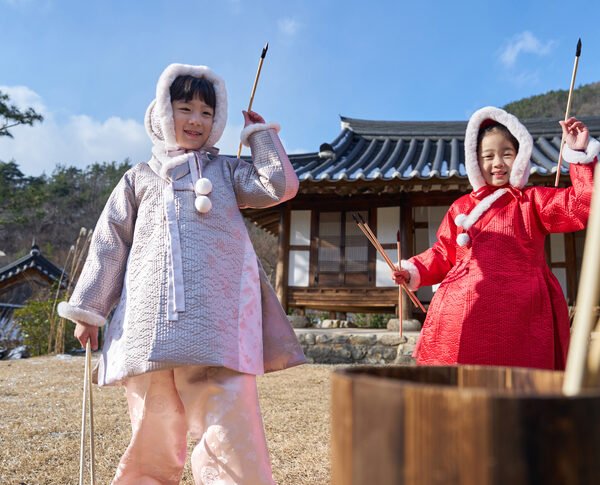Experience the diverse and unique world of Korean food, also known as hansik. From the distinct separation of main dishes and side dishes to the balanced mix of animal and plant products, every bite of Korean cuisine tells a story. The increasing popularity of “K-Food” around the globe is no surprise, as it not only satisfies the taste buds but also offers numerous health benefits. The rich and refined flavors of fermented foods like doenjang, ganjang, and gochujang add depth to every dish. And let’s not forget about the beloved kimchi, a staple side dish made through the art of fermentation. With popular dishes like bibimbap, bulgogi, and japchae, as well as delightful treats like rice cakes, Korean food is an adventure waiting to be explored. And let’s not forget about the traditional alcoholic beverages, makgeolli and soju, which add a touch of authenticity to any Korean dining experience. Get ready to embark on a culinary escapade like no other with Korean food.

Korean Food: A Diverse and Unique Culinary Experience
Korean food, known as hansik, is renowned for its diversity and uniqueness. It is a result of Korea’s natural environment and rich culinary cultures. The country’s unique geography and climate have influenced its cuisine, which has a distinct taste and preparation method. Additionally, Korean food stands out for its clear distinction between the main dish and side dishes, diverse recipes to suit every palate, a balanced mix of animal and plant products, and its refined fermented foods. Let’s explore the fascinating world of Korean cuisine and its various aspects in more detail.
The Influence of Korea’s Natural Environment and Culinary Cultures
Geo-climatic Factors Shaping Korean Cuisine Korea’s natural environment, characterized by its mountains, seas, and four distinct seasons, plays a crucial role in shaping its cuisine. The varied geography and climate provide a wide range of ingredients, which are utilized in the preparation of Korean dishes. The rugged mountains offer an abundance of wild vegetables and medicinal herbs, while the surrounding seas provide fresh seafood. These natural resources contribute to the unique flavors and textures found in Korean cuisine.
Regional Variations in Korean Food Korea’s culinary culture is also influenced by its historical regional divisions. Each region has its own specialty dishes and cooking methods, resulting in a diverse culinary landscape throughout the country. For example, the coastal regions are known for their seafood-based dishes, while the mountainous regions are renowned for their vegetable and herb-focused cuisine. This regional variation adds depth and richness to Korean food and ensures that there is something for everyone to enjoy.

Distinctive Features of Korean Food
Clear Distinction Between Main Dish and Side Dishes One of the distinctive features of Korean food is its clear distinction between the main dish and side dishes. A typical Korean meal consists of rice, soup, and several side dishes known as banchan. These side dishes are designed to complement the main dish and provide a variety of flavors, textures, and nutrients. They can range from simple pickled vegetables to more elaborate preparations such as braised meats or stir-fried seafood. This emphasis on a balanced meal showcases the importance of harmony and balance in Korean cuisine.
Diverse Recipes to Satisfy Every Palate Korean cuisine offers a wide range of recipes to satisfy every palate. From spicy and savory dishes to mild and comforting flavors, there is something for everyone to enjoy. Whether you prefer meat-based dishes like bulgogi (grilled marinated beef) or vegetarian options like bibimbap (mixed rice with vegetables), Korean cuisine has it all. The diverse recipes reflect the creativity and adaptability of Korean chefs, who constantly innovate while staying true to the traditional flavors.
Balanced Mix of Animal and Plant Products Another distinctive feature of Korean food is its balanced mix of animal and plant products. The cuisine emphasizes the importance of a well-rounded diet by incorporating various ingredients from both sources. Meat and fish provide essential proteins, while vegetables, grains, and legumes offer vital vitamins, fiber, and minerals. This balanced approach contributes to the overall healthfulness of Korean cuisine and ensures that each meal is both satisfying and nutritious.
The Art of Fermentation: Refined and Flavorful Foods Fermentation is an integral part of Korean cuisine and is considered an art form. It is used to create a variety of condiments and side dishes that add depth and complexity to the flavors. Fermented foods like kimchi, doenjang, ganjang, and gochujang are essential in Korean cooking. They undergo a natural fermentation process that not only enhances their taste but also preserves them for longer periods. This ancient technique not only adds unique flavors but also provides probiotics and other health benefits, making Korean food both delicious and beneficial for digestion.
K-Food: Gaining Popularity Worldwide
The Rise of K-Food in Global Culinary Trends In recent years, Korean food, also known as K-Food, has gained immense popularity worldwide. Its unique flavors, presentation, and health benefits have captivated the hearts and taste buds of people all around the globe. Previously considered an exotic cuisine, Korean food is now featured in international culinary events, food festivals, and is increasingly available in restaurants and grocery stores worldwide. This rise in popularity is a testament to the global appeal and versatility of Korean cuisine.
Recognizing the Health Benefits of Hansik The increasing popularity of K-Food is not just about its delectable taste. Korean cuisine, hansik, is also recognized for its health benefits. The emphasis on balance, variety, and the inclusion of fermented foods make it a nutritious choice. Traditional Korean ingredients like garlic, ginger, sesame oil, and various spices have been hailed for their medicinal properties. Additionally, the focus on fresh and seasonally available ingredients ensures that meals are packed with vitamins, minerals, and antioxidants. As more people prioritize their health and well-being, Korean food offers a delicious and nutritious option.
World Health Organization’s Endorsement The World Health Organization (WHO) recognizes the nutritional benefits of Korean cuisine and has endorsed it as a superb culinary model with nutritional balance. The WHO praises the balanced combination of grains, vegetables, and fermented foods present in Korean meals. This endorsement further solidifies the credibility and reputation of Korean food as a healthy and well-rounded culinary choice.

Fermented Foods: Essential Condiments in Korean Cuisine
Doenjang: A Savory and Versatile Soybean Paste Doenjang is a savory and versatile soybean paste that is popularly used in Korean cuisine. It is made by fermenting soybeans and salt, resulting in a rich and complex flavor. Doenjang is often used as a base for soups, stews, and sauces, adding depth and umami to the dishes. Its distinctive taste and aroma make it an essential ingredient in many Korean recipes.
Ganjang: The Flavorful Korean Soy Sauce Ganjang is a flavorful soy sauce that is an integral part of Korean cooking. It is made by fermenting soybeans and is known for its savory and salty taste. Ganjang is used as a seasoning agent in various dishes, such as stir-fries, marinades, and dipping sauces. Its umami-rich flavor enhances the taste of the ingredients and adds a delicious depth to the overall dish.
Gochujang: A Spicy and Flavorful Red Pepper Paste Gochujang is a spicy and flavorful red pepper paste that is widely enjoyed in Korean cuisine. It is made by fermenting a mixture of red chili powder, soybeans, rice flour, and salt. Gochujang adds a unique kick to dishes and is used as a seasoning or condiment in soups, stews, marinades, and dipping sauces. Its fiery taste and vibrant color make it a staple in Korean kitchens.
Kimchi: The Staple Side Dish
The History and Significance of Kimchi Kimchi is one of the most popular and iconic Korean dishes. It has a long history and holds a significant place in Korean culture. Kimchi is made by fermenting a mixture of salted cabbage, radish, and a paste made of red chili powder, garlic, ginger, and other ingredients. It is an important side dish served with almost every Korean meal. Kimchi not only adds a burst of flavor to the meal but also contributes to a healthy gut due to its probiotic properties.
The Process of Making Kimchi The process of making kimchi is a labor of love. It involves salting the cabbage to draw out excess moisture, preparing the paste, and then meticulously layering the cabbage leaves with the paste. The kimchi is then left to ferment for a specific period, allowing the flavors to develop and the ingredients to transform. This fermentation process imparts a unique tangy taste and enriches the nutritional value of the dish.
Varieties of Kimchi There are numerous varieties of kimchi, each with its own distinct flavor and ingredients. The most common type is baechu kimchi, made with Napa cabbage. Other popular varieties include oi sobagi (cucumber kimchi), kkakdugi (radish kimchi), and yeolmu kimchi (young radish leaf kimchi). Each variety has its own taste and texture, offering a wide range of options to suit different preferences and dishes.
Kimchi’s Importance in Korean Culture Kimchi is deeply ingrained in Korean culture and holds great significance. It is not only a staple side dish but also represents the spirit of Korean unity and resilience. It is traditionally prepared in large quantities during the winter, when fresh vegetables are scarce. Families and communities gather together to make kimchi, fostering a sense of togetherness and shared heritage. Kimjang, the kimchi-making process, has even been recognized by UNESCO as an Intangible Cultural Heritage of Humanity. This cultural significance reflects the deep-rooted connection between Koreans and their beloved kimchi.
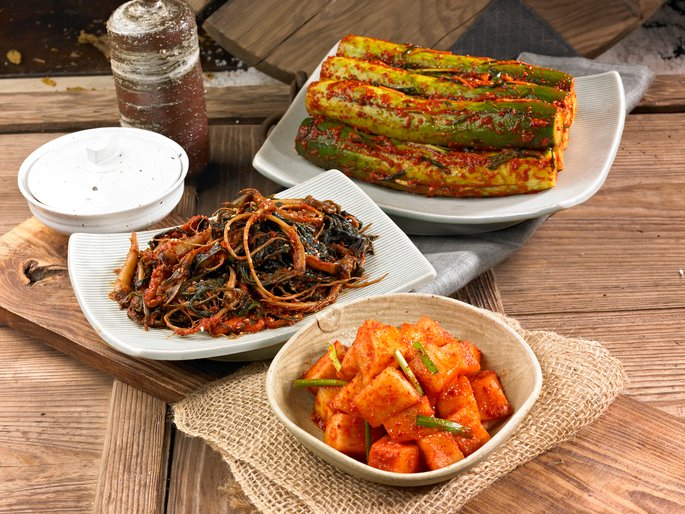
Popular Korean Dishes
Bibimbap: A Colorful and Nutritious Mixed Rice Dish One of the most beloved Korean dishes is bibimbap. It consists of a bowl of mixed rice topped with various vegetables, meat, and a spicy sauce. The colorful presentation of different ingredients makes bibimbap visually appealing, and the combination of flavors and textures makes it a truly satisfying meal. It is often served with a fried egg on top, and the crispy rice that forms at the bottom of the bowl adds a delightful crunch.
Bulgogi: Grilled Marinated Beef Delight Bulgogi is a mouthwatering dish made with thinly sliced marinated beef that is grilled to perfection. The beef is typically marinated in a blend of soy sauce, sugar, garlic, and other seasonings. Bulgogi is known for its tender and juicy texture, and the sweet and savory marinade adds a burst of flavor. It is often served with lettuce leaves, which are used to wrap the beef along with rice and various condiments.
Japchae: A Venerated Korean Stir-Fried Glass Noodle Dish Japchae is a revered Korean dish made with stir-fried glass noodles, vegetables, and meat. The noodles are made from sweet potato starch and have a chewy and translucent texture. Japchae is a versatile dish that can be enjoyed as a side dish or a main course. It is commonly seasoned with soy sauce, sesame oil, and sesame seeds, resulting in a savory and nutty flavor. The combination of colorful vegetables and tender meat makes japchae a visually appealing and delicious dish.
Other Delectable Korean Dishes Apart from bibimbap, bulgogi, and japchae, Korean cuisine boasts a wide array of other delectable dishes. Some noteworthy examples include galbi (grilled marinated beef or pork ribs), jjajangmyeon (noodles with black bean sauce), samgyeopsal (grilled pork belly), and dakgalbi (spicy stir-fried chicken). With such a diverse range of flavors and preparations, there is truly a Korean dish to suit every taste and occasion.
Rice Cakes: A Delightful Treat
Tteok: The Chewy and Sweet Rice Cake Tteok, or rice cake, is a delightful treat enjoyed in Korea. It is made from glutinous rice flour and can have various shapes and sizes. Tteok can be enjoyed in both sweet and savory dishes. For example, in tteokbokki, it is stir-fried in a spicy sauce, while in tteokguk, it is added to a flavorful soup. The chewy texture and mild sweetness of tteok make it a popular choice for special occasions and everyday snacking.
Tteokbokki: Spicy Rice Cake Stir-Fry Tteokbokki is a beloved Korean street food dish that features tteok stir-fried in a spicy sauce. The sauce is typically made with gochujang, red pepper paste, along with other seasonings. Tteokbokki is known for its rich and fiery flavor, and it is often garnished with green onions, fish cakes, and boiled eggs. Its addictive taste and chewy texture have made it a favorite among Koreans and tourists alike.
Special Occasions and Rice Cake Customs Rice cakes hold special significance in Korean culture and are often associated with important occasions and celebrations. For example, tteokguk, a soup made with sliced rice cakes, is a traditional dish served during the Korean New Year. It symbolizes good luck and the passing of another year. Additionally, on the first birthday of a child, a special dish called baekseolgi is prepared, featuring a tower of colorful rice cakes. This custom signifies good fortune and prosperity for the child’s future.
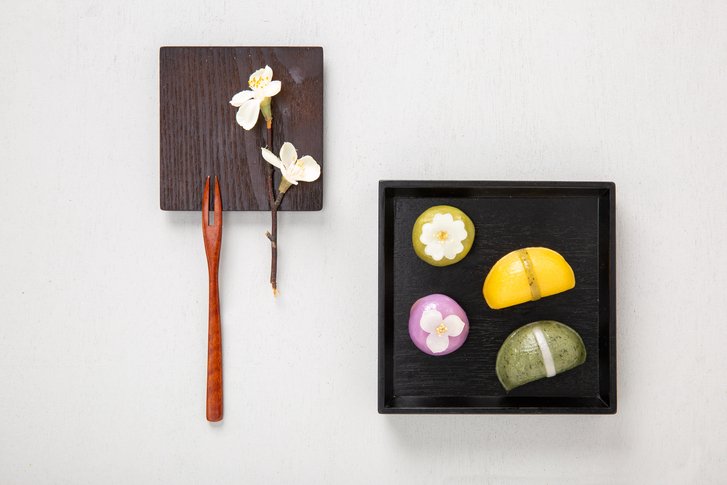
Traditional Korean Liquor: Indulging in Local Spirits
Makgeolli: The Traditional Rice Wine Makgeolli is a traditional Korean rice wine that has been enjoyed for centuries. It is made by fermenting rice with nuruk, a traditional fermentation starter. Makgeolli has a milky appearance and a mildly sweet and tangy taste. It is often enjoyed in social gatherings and pairs well with various Korean dishes. The fizzy and refreshing nature of makgeolli makes it a popular choice, especially during warmer months.

Soju: Korea’s Iconic Distilled Spirit Soju is a highly popular distilled spirit in Korea and has become a global sensation. It is typically made from rice, although other starches like sweet potatoes or barley can be used. Soju has a neutral taste and is usually consumed straight or mixed with other beverages. It is known for its high alcohol content yet smooth and clean finish. Soju is a staple in Korean nightlife and is often chosen as the drink of choice during festive occasions and gatherings.
Appreciating Korean Liquor Culture Korean liquor culture is deeply rooted in tradition and plays a significant role in social gatherings and celebrations. Koreans value the art of pairing food and liquor, with specific types of alcohol complementing specific dishes. There are also specific etiquette and customs associated with drinking, such as pouring drinks for others and using two hands when receiving a glass. This emphasis on community and respect adds to the overall experience of indulging in Korean liquor.
Pairing Korean Liquor with Food Korean liquor, such as makgeolli and soju, is often enjoyed with food. The wide range of flavors and alcohol content provides an excellent opportunity for pairing with various dishes. For example, the refreshing and slightly sweet taste of makgeolli pairs well with spicy dishes like tteokbokki. On the other hand, the clean and neutral flavor of soju is a versatile choice that can be enjoyed with everything from grilled meats to seafood. The art of pairing Korean liquor with food enhances the overall dining experience and elevates the flavors of both the dish and the drink.
In conclusion, Korean cuisine offers a diverse and unique culinary experience that is deeply rooted in Korea’s natural environment and rich culinary cultures. From the influence of the natural geography to the balanced mix of animal and plant products, every aspect of Korean food reflects its origins and the commitment to flavor and nutrition. The rise of K-Food in global culinary trends and the recognition of its health benefits by the World Health Organization further solidify its position as a culinary gem. From fermented condiments to staple side dishes like kimchi, Korean cuisine offers a feast for the senses. Popular dishes like bibimbap, bulgogi, and japchae showcase the vibrant flavors and textures, while rice cakes and traditional liquors provide delightful treats for special occasions. Embark on a culinary journey and savor the diverse and unique flavors of Korean food.

